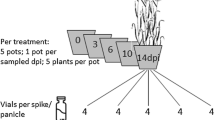Abstract
Rice leaves were inoculated with spores of Magnaporthe grisea, and the number of fluorescence-labeled spores that attached to the leaf surface were counted before and after leaves were dipped and then stirred in water. Just 5% of the spores were retained on the leaf surface 1 h after inoculation; the percentage retained then increased rapidly between 1.25 and 1.50 h, and most had attached by 2 h. Scanning electron microscopy revealed that most conidia were lying on a few wart-like protuberances 2–4 µm high. Spores became attached when the germ tubes were long enough to reach the leaf surface, at least 3 µm, by mucilaginous substances at the tip. Retained spores swayed when water was added under the cover glass from one side, indicating that the attachment was confined to the tips of germ tubes. Spores are attached to the rough leaf surface by mucilaginous substances – not at the tip of spore as reported on smooth artificial substrates but at the tip of the germ tubes.
Similar content being viewed by others
Author information
Authors and Affiliations
Corresponding author
Rights and permissions
About this article
Cite this article
Koga, H., Nakayachi, O. Morphological studies on attachment of spores of Magnaporthe grisea to the leaf surface of rice. J Gen Plant Pathol 70, 11–15 (2004). https://doi.org/10.1007/s10327-003-0085-4
Received:
Accepted:
Issue Date:
DOI: https://doi.org/10.1007/s10327-003-0085-4




